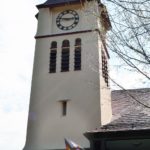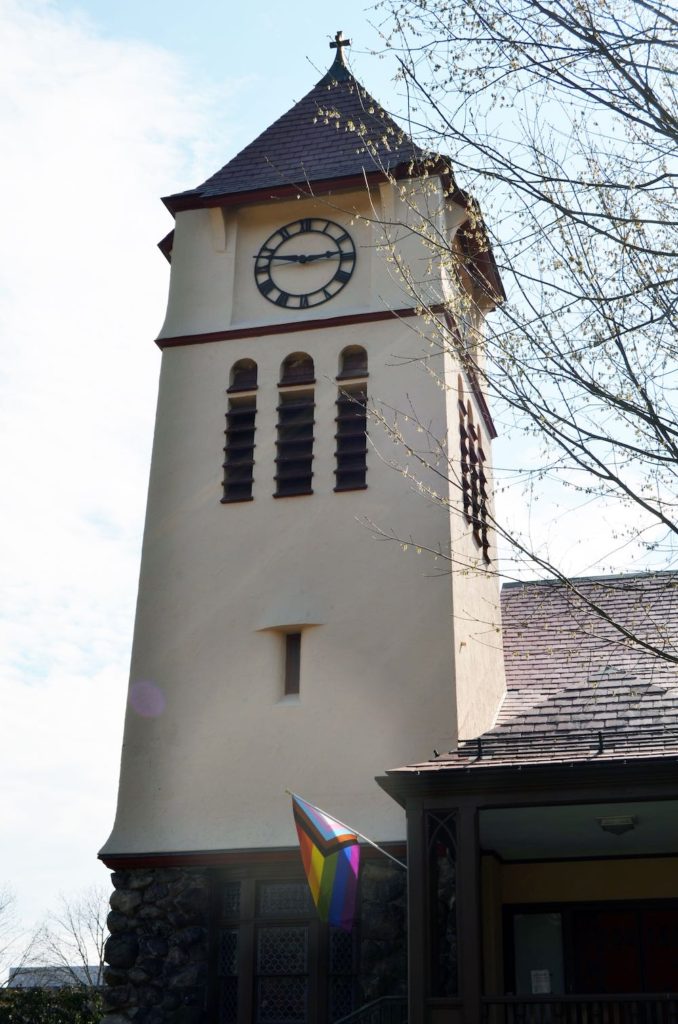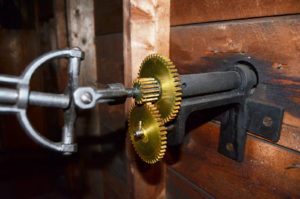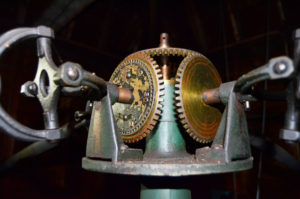
By Michael Flamang
Since the invention of mechanical clocks in Renaissance Europe, town governments have installed clocks in prominent buildings in town centers to standardize time in support of commerce. In New England, many of the clocks that we see in historic churches on town greens were purchased and maintained by town select boards.
In Belmont, in 1889, Town Meeting voted “that the selectmen be authorized to place a clock in the new Unitarian Church to be erected this year and the sum of $500 be appropriated for the same.”
When the church was dedicated in 1890, the clock was in its tower. Manufactured by the E. Howard Watch and Clock Company of Boston, the clock rang the bronze bell for decades.
The clock still sits in the tower of that church, overlooking the historic Wellington train depot, a magnificent copper beech tree, and the town green on Concord Avenue.
Unfortunately, the clock hasn’t functioned since 2006.
History Since Belmont Began
The clock rings a 1,200-pound bronze bell that was cast in 1857 in Boston by the Henry H. Hooper Company. Hooper was an apprentice of Paul Revere. On March 18, 1859, the bell rang out the news of the incorporation of the new town of Belmont from the original church, which was located on the site of the current post office until it was destroyed by fire on February 12, 1890.
The separation of church and state was observed differently in the mid-19th century. The original church building, the spire of which appears on the town seal, served as the location of town meetings until 1867. It also housed the town’s library and the Farmers Exchange. The church was originally called the Belmont Congregational Society. It was later renamed the First Church in Belmont Unitarian Universalist (FCBUU).
The clock ran dependably until the early 2000s, but years of accumulated dust on the gears began to interfere with the movement, and in 2006, the clock stopped.
The Jewel in the Town
Tower clocks need a source of power to turn the gears of the movement and to ring the bell. That power source is gravity, acting on weights, through cables and pulleys that descend slowly to do the work of turning the hands and ringing the bell. Once a week, the clock winder climbs a ladder inside the tower to the platform where the clock movement is located and winds the clock by raising the weights with a hand crank and lots of muscle effort.
Over the decades, the church sexton has been the clock winder. The town compensated the sexton for this effort with an annual stipend of $36 per year in 1890, which grew to $150 in recent years. In 2006, the church administrator stopped requesting the stipend because the clock had stopped running.
Until December 2020, access to the clock movement meant a daunting climb up a long, wobbly ladder. The ladder was showing its age, and eventually, clock repair craftspeople refused to service the clock because of the condition of the ladder. In December 2020, the church replaced the rickety ladder with a new set of stairs that reached the upper level of the tower for access to the clock movement. Clock service people can now climb safely to the movement.
Since the clock was first installed, our world has created electric and electronic clocks. The Church Property Committee considered replacing the entire timekeeping mechanism with an electric movement. The cost and benefits of that approach are being considered. A hybrid solution is also being considered which involves restoring the historic weight-driven movement and electrifying the winding.
Historic Preservation Funds Needed
In September 2018, FCBUU applied for a Community Preservation Act (CPA) grant for $66,250 to repair the town’s old tower clock. In January 2019, the Community Preservation Committee voted to advance the application with a recommendation that it be approved.
A substantial part of the project cost estimate in the first grant application, however, was to pay for the replacement of the decrepit ladder. As the grant application was reviewed by various town committees, the ladder portion of the project drew the most comments because it consisted of work that would be done to the church building itself. The grant application received a negative recommendation from the Warrant Committee, and FCBUU withdrew the application
There is precedent, however, for CPA funds granted to repair clocks in church buildings. The Community Preservation Coalition, a state clearinghouse of information, maintains a database of CPA-funded projects. The database includes many projects in other towns that funded the repair of tower clocks in church buildings, often with funds routed through an intermediary organization like a historical society.
Following the withdrawal of the grant application, the FCBUU Property Committee reviewed its options as stewards of this historic town artifact and decided that the church could pay for a new tower ladder using operating funds.
Today, thanks to the ladder replacement, all work remaining to restore the clock to operation can be performed by clock repair craftspeople. FCBUU has received proposals from three craft horologist workshops. The clock repair work will cost about $30,000.
Antique Timepiece is a Community Heirloom
Visitors and residents of Belmont should be able to see the correct time on this tower clock when they walk, bicycle, or drive into the center. An operating historic clock makes a proud statement about stewardship of the town’s historic treasures.
Michael Flamang is co-chair of the Property Care Committee of the First Church in Belmont Unitarian Universalist.





Sorry, the comment form is closed at this time.